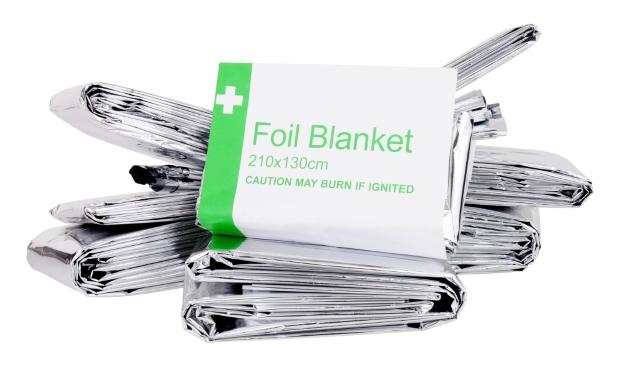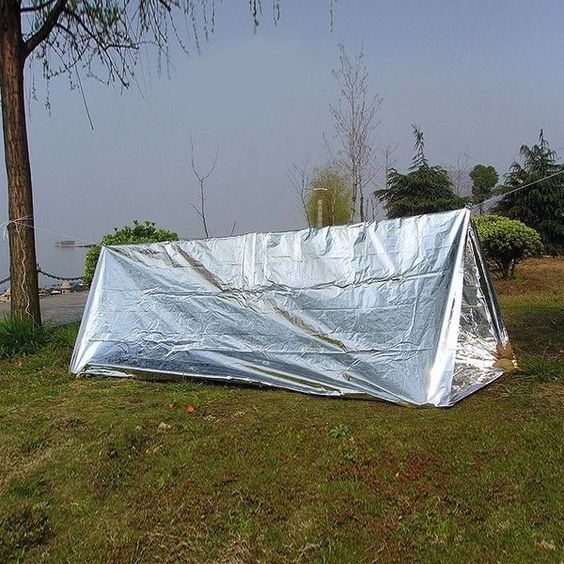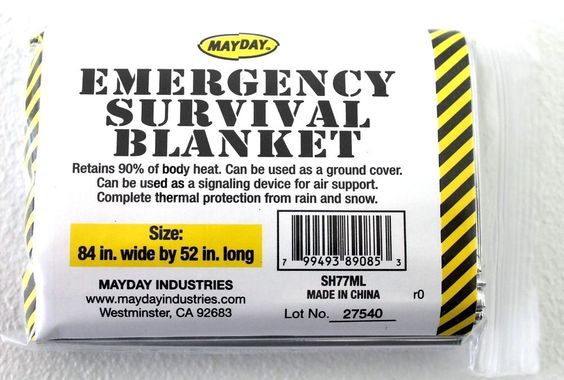Did you ever wonder how you would survive if your vehicle breaks down and you get stuck in it during a blizzard?
Such hazardous situations occur every year, and the freezing temperature makes survival a lot more difficult.
You can still hope to find a proper shelter if you are in the city, but what if you are in the middle of nowhere? In such a scenario, you will need something that can keep you warm and comfortable until help arrives. Your salvation and perhaps your only option to not freeze to death is a space blanket or emergency blanket. It is an innovative blanket, designed especially to protect you during precarious situations.
What is an emergency blanket?
The emergency blanket is a ground-breaking blanket, designed especially to protect your body from cold during dangerous situations. It is also known by many as the space blanket, Mylar blanket, first aid blanket, safety blanket, heat sheet, and weather blanket.
It’s a lightweight and low-bulk blanket, which is prepared from a heat-reflecting plastic sheet. It looks like aluminum foil, but it is far from being an aluminum foil blanket. The space blanket was developed by NASA, and the main purpose behind its creation was the coating around the exterior surface of space crafts. Since it offers exceptional thermal control, it was quite useful for them, but it also found its way into our daily lives.
The emergency blanket prevents heat loss regardless of how cold the temperature outside is. It helps the body maintain an optimum temperature, and that alone makes it an essential tool for surviving under adverse circumstances. If folded properly, you can carry it in your pocket, and you will find at least one emergency blankets in today’s survival kits.
The hikers and mountaineers love the space blanket the most because they often need it during bad weather. You can pack your emergency blanket easily in your first-aid kit and carry it with you anywhere you travel. It will be your body’s ultimate defense against the cold weather.
Alternative uses for preppers and survivalists:
Since you probably already have an emergency blanket in your kit, it’s better to learn to use such a blanket to its full extent. Here are some unconventional survival uses for it:
1. Signaling for help
Your emergency blankets usually have a silver or gold chrome-like finish. This is a design feature that can definitely come in handy when you get lost in unfamiliar territory.
The mirrored reflective surface of a space blanket is great to bounce light off of and signal for help. In some scenarios, people getting lost in the forested areas were saved by rescue teams because they had the inspiration to tie an emergency blanket up on a tall tree.
The wind caused the emergency blanket to move, and it created a fluttering light reflection that was noticeable from afar. If you have one in your survival bag, you can also use it to reflect the sunlight when you notice a passing plane.
2. Gathering water
Your space blanket is essentially a large sheet of non-porous material. This makes it an ideal tool for catching and collecting water. There are various ways you can use it to collect water, and all you need is a little bit of rainfall. The easiest way to collect water is to dig a hole in the ground and line it with the emergency blanket so that you form a mini pool to collect the water. If you decide to use this method, make sure you raise the edges to avoid any dirty runoff.
Another good alternative to gather water is to tie up the four corners of the blanket onto trees and use a rock to weight down the middle. Rainfall will collect at the bottom of the funnel. If you have a container, you can improvise a funnel or slide from your emergency blanket and divert any running water in your recipient.
During the wintertime, you can shape it into a cone and place snow into it. Afterward, by carefully aligning the cone to catch the sunlight, you will be able to melt the snow and obtain a good quantity of water.
3. Building a shelter
There are many ways to use your emergency blanket to build or improvise a shelter. The main idea here is to use it as you would use a tarp. There are tens of shelter models you can improvise from a tarp, and the same goes for your emergency blanket.
To avoid destroying the blanket, you will need to learn how to tie it down without puncturing it. Using a paracord and even some duct tape should do the trick.
4. Heat reflector
Many people don’t know that an emergency blanket has a melting temperature of 500 degrees Fahrenheit. This characteristic makes it relatively safe in close proximity to open fire.
I’ve used a space blanket on various occasions to reflect heat from my campfire back into my emergency shelter. Even if all you have is a small heating source, you can still use the blanket to amplify its effect. Get as close as possible to the heat source and cover yourself with the blanket to say warm.
5. Good insulator
The space blanket is a great insulator from the cold, and it can be used to improve your sleeping arrangement. On various occasions, I’ve used my blanket to insulate the sleeping bags of my fellow campers. I’ve even used it with my survival hammock, and it did a great job of keeping me warm.
In a desperate situation, where you need to retain as much body heat as possible, you can cut the blanket up and stuffed it into your shoes and gloves to help keep warm. It is a great aid if you get lost in the wilderness during inclement weather.
According to the life stories of the less fortunate ones, homeless people have been using space blankets for quite some time, and they rely on it to keep warm when cardboard is not available.
6. Medical aid
One of the basics of wilderness first aid is learning how to take care of yourself when professional medical help is not available. There are various first aid courses that will teach you how to use your emergency blanket to fashion a makeshift slink to help better immobilize a broken or sprained arm.
In more dire scenarios where you have to deal with a bleeding wound, you can even use it as a tourniquet. You can use strips from your emergency blanket to tie sticks to a leg or arm and create a splint. In desperate times, it can even act as an impromptu compression bandage if needed.
7. Cooking
There are few people good at survival improvised cooking, while for the rest, cooking can be a difficult task if they lack proper gear. If you have an emergency blanket, the day may be saved since there are many ways it can help you cook your food. For example, you can improvise a bowl from your blanket and face it into the sun. Then place thinly sliced meat and other available foods into it and let the sun to do all the work.
If you manage to start a fire (which you should), the space blanket can be used to wrap your food and to cook it near the fire. Pay attention, since you don’t have to put the wrapped food on the fire as that will not work. You just have to put it near enough the fire so that the heat delivered by the fire heats the blanket enough to cook what’s inside.
 8. Starting a fire
8. Starting a fire
Your emergency blanket reflects nicely, and they can be successfully used to start a fire, just like a mirror. All you need is proper kindling, patience, and the right angle to concentrate the sunlight into the center of the kindling. After some time, the sun’s light will ignite the kindling, and you will have a nice fire going. How you maintain the said fire, it’s probably much more difficult than starting it when you don’t have enough fuel.
The reflective properties of the emergency blanket can also come in handy when you’re dealing with the scorching sun. You can create a nice sunshade if you want to stay cool and catch your breath.
9. Fishing
Although personally, I’ve never tried this method, I’ve heard that many survivalists learned how to fish using strips from an emergency blanket, fashioned as lures.
According to most fishermen, fish like shiny things, and they are attracted by the emergency blanket strips. Now, regardless of what fish like, if you manage to catch one, the blanket can also be used to clean the fish and keep the dirt off your meat.
10. Waterproofing supplies
Your emergency blanket is completely waterproof, and this makes it ideal for wrapping or shielding items from falling water. Survivalists and outdoorsmen used to backpack items wrapped in a space blanket in order to keep them dry when crossing rivers. To keep the contents of your backpack dry, place everything on the blanket then wrap the blanket prior to placing it in the backpack.
Some camping enthusiasts used to wrap foods and other vital items in an emergency blanket and bury them when leaving their campsite. This would protect the food and their other items from wild animals or wanderers that would stumble into their campsite.
Concluding
A space blanket is an ideal, multi-use tool for every survivalist. It has many more uses than the ones listed in this article, and it’s all up to your imagination on how you use one, but also depending on the situation, you find yourself in.
Remember that necessity is the mother of invention, and having an emergency blanket in your bug out bag or in your EDC is a great way of making sure you made a small but important step to being more prepared.

























































































Am I the only one who has ever tried to sleep outdoors on the ground in 40F weather with nothing but a space blanket as a test of said space blanket and nearly froze to death and spent my most miserable outdoor night ever? You are much better off toting an 11×14 plastic ripstop tarp.
Space blankets can’t help with thermal conduction or body parts exposed to wind chill.
You have to be off the ground and protected from the wind. Then you will be warm from the heat reflection. (shiny side pointed towards your body).
I would never spend a night with ONLY a mylar blanket. But they are lifesavers in a tent, car, leanto, etc.
Agree w Yo… Lying directly on the ground , you only have a few thousandths of an inch between you and the freezing temp, and the direct contact allows Very efficient heat transfer from body to earth. AIR is A great Thermal Barrier, so if you make a bed of leaves, or grass, that traps lots of air in the small spaces. Even crumbled Twigs or stalky bits of reeds can help if they don’t actually pierce the mylar. People have survived blizzards by digging into snow banks, lining the bottom with grass, leaves and plant material, then closing the opening as much as possible. Of course, make the hole big enough that you have some air and room to breathe. The snow is going to be a little permeable anyway, and the entrance will allow for some circulation. With the plant material bed, WRAP the mylar sheet around your torso, INSIDE your Jacket/Coat will help keep it closed around you. This Reflects the heat inward, and can be very effective way of maintaining your core temperature. Good strategy inside a vehicle. Look for a pine tree low to the ground, that will often have some space under the low branches where you can dig a protected shelter.
DO NOT run your vehicle engine to stay warm. Even IF the snowing stops, you’ll get Carbon Monoxide buildup inside, and THAT can kill.